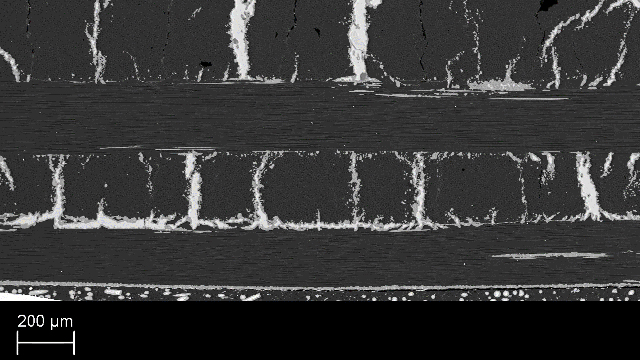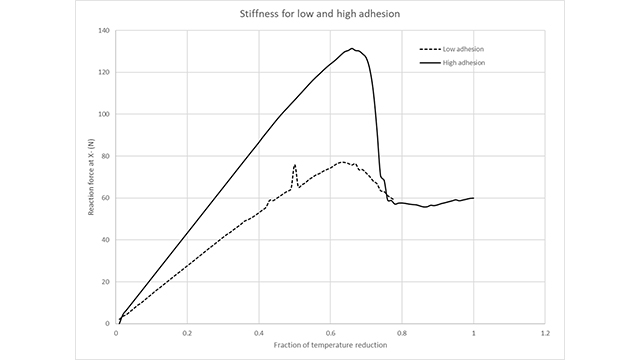Crack propagation in composites and how to avoid it: A DLR case study

Composites are increasingly being used in various industries. Compared to metals, composites have higher strength, lighter weight, and are more resistant to corrosion.
Ceramic matrix composites improve space applications
Ceramic matrix composites (CMCs) have become especially popular in space applications due to their ability to withstand extremely high temperatures. At the German Aerospace Center (DLR), researchers are investigating the use of CMC components for high-temperatures and demanding-environment applications.
The simulation group at DLR’s Institute of Structure and Design recently began modeling the process of pyrolysis. This is an intermediate step in the production of CMCs. During pyrolysis, carbon fiber reinforced polymers (CFRPs) are heated to temperatures up to 1,600 degrees Celsius and then cooled down.
The team needed to understand how temperature change would affect the CMC’s microstructure, especially microcracking. Changes at the microstructural level tend to affect the behavior of the material. As a result, this affects the performance of the overall part. Therefore, understanding of the microstructural behavior is crucial for future CMC components produced by DLR. This includes nozzles for rockets and turbine shrouds for aero engines, among other applications.

Composites present unique challenges
Despite the advantages offered by composites, they also present unique challenges. Composites can behave differently depending on their constituents and the manufacturing process. Additionally, damage at the microstructure, such as cracking, initially affects the overall stiffness. However, it eventually can propagate and cause the entire part to fail. Accurate simulation of composites is also frequently misunderstood and does not offer full insight into microstructural behavior.
The team needed to understand where and how pyrolysis could cause early cracking at the material microstructure during manufacturing. They also had 30 possible fiber and matrix combinations that they needed to explore. The cost to physically test each potential combination was extremely high.
DLR explored several simulation platforms to help them reduce the time and cost to test the 30 potential combinations. The team was unable to find any tools that could perform multiscale simulations to the required levels of detail and accuracy. Additionally, none of the tools widely available at the time contained the material and damage models, such as cracking, that DLR was looking for.

Modeling microstructural cracking
In 2018, the team began using Simcenter™ Multimech™ software to explore the effects of pyrolysis on CMCs.
“Simcenter Multimech allowed us to model microstructural cracks and determine how they would affect the overall part,” said Neraj Jain, group leader in simulation and engineering at the DLR Department of Ceramic Composites and Structures. “Using this tool, we can actually see where a crack is developing, how the crack will change our material, and how it will affect the final microstructure of the material.”
Using Simcenter Multimech, the engineers could vary the interface strength between fiber and ceramic matrix. This is possible to control via manufacturing treatments/conditions. It allowed them to evaluate how this parameter would influence crack initiation and propagation. Additionally, this insight enabled DLR to optimize the material and tailor it according to microstructural mechanics. This is a crucial step to accurately understand how a part will behave as a whole.
Finally, Simcenter Multimech came prepackaged with advanced damage and material models not available in other commercial solutions. Using other software platforms, the DLR team would have needed to create these models themselves.

Increasing productivity with simulation
The DLR team realized numerous time and cost savings using Simcenter Multimech. “For a final part, we have 30 possibilities of fiber and matrix combinations that we have to test individually in order to visualize cracking,” said Jain. “Using Simcenter Multimech, we can narrow down the number of combinations we need to physically prototype to just three or four, a reduction of 90%. This can save us 30% in time and cost, as we no longer need to physically prototype so many potential combinations.”
The team anticipates that they will be able to reduce the amount of time it takes to run simulations by 30%. This is due to the inclusion of unique material and damage models in Simcenter Multimech, such as cracking, as they no longer need to create those models manually.
“Before Simcenter Multimech, we considered developing our own code to perform these analyses,” said Jain. “That process would have taken us at least two years. The Simcenter team is extremely responsive to our needs. They develop new features based on our requests, saving us years of development work.”
“The efficient integration of Simcenter Multimech with our other FEA tools increases our productivity and brings us closer to our aim of optimizing CMC materials virtually. There is no software available on the market that is as easy to use as Simcenter Multimech and that can handle such complex multiscale problems. The way we are able to conduct crack modeling and multiscale simulation will provide lots of opportunities in many projects to come.”


